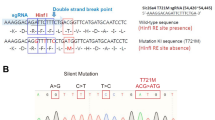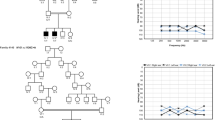Abstract
The pathophysiologic pathways and clinical expression of mitochondrial DNA (mtDNA) mutations are not well understood. This is mainly the result of the heteroplasmic nature of most pathogenic mtDNA mutations and of the absence of clinically relevant animal models with mtDNA mutations. mtDNA mutations predisposing to hearing impairment in humans are generally homoplasmic, yet some individuals with these mutations have severe hearing loss, whereas their maternal relatives with the identical mtDNA mutation have normal hearing1,2. Epidemiologic, biochemical and genetic data indicate that nuclear genes are often the main determinants of these differences in phenotype3,4,5. To identify a mouse model for maternally inherited hearing loss, we screened reciprocal backcrosses of three inbred mouse strains, A/J, NOD/LtJ and SKH2/J, with age-related hearing loss (AHL). In the (A/J×CAST/Ei)×A/J backcross, mtDNA derived from the A/J strain exerted a significant detrimental effect on hearing when compared with mtDNA from the CAST/Ei strain. This effect was not seen in the (NOD/LtJ ×CAST/Ei)×NOD/LtJ and (SKH2/J×CAST/Ei)×SKH2/J backcrosses. Genotyping revealed that this effect was seen only in mice homozygous for the A/J allele at the Ahl locus on mouse chromosome 10. Sequencing of the mitochondrial genome in the three inbred strains revealed a single nucleotide insertion in the tRNA-Arg gene (mt-Tr) as the probable mediator of the mitochondrial effect. This is the first mouse model with a naturally occurring mtDNA mutation affecting a clinical phenotype, and it provides an experimental model to dissect the pathophysiologic processes connecting mtDNA mutations to hearing loss.
This is a preview of subscription content, access via your institution
Access options
Subscribe to this journal
Receive 12 print issues and online access
$209.00 per year
only $17.42 per issue
Buy this article
- Purchase on Springer Link
- Instant access to full article PDF
Prices may be subject to local taxes which are calculated during checkout



Similar content being viewed by others

References
Prezant, T.R. et al. Mitochondrial ribosomal RNA mutation associated with both antibiotic-induced and non-syndromic deafness. Nature Genet. 4, 289–294 (1993).
Fischel-Ghodsian, N. Mitochondrial deafness mutations reviewed. Hum. Mutat. 13, 261–270 (1999).
Jaber, L. et al. Sensorineural deafness inherited as a tissue specific mitochondrial disorder. J. Med. Genet. 29, 86–90 (1992).
Guan, M., Fischel-Ghodsian, N. & Attardi, G. Biochemical evidence for nuclear gene involvement in phenotype of non-syndromic deafness associated with mitochondrial 12S rRNA mutation. Hum. Mol. Genet. 5, 963–972 (1996).
Bykhovskaya, Y. et al. Candidate locus for a nuclear modifier gene for maternally inherited deafness. Am. J. Hum. Genet. 66, 1905–1910 (2000).
Graham, B.H. et al. A mouse model for mitochondrial myopathy and cardiomyopathy resulting from a deficiency in the heart/muscle isoform of the adenine nucleotide translocator. Nature Genet. 16, 226–234 (1997).
Melov, S. et al. A novel neurological phenotype in mice lacking mitochondrial manganese superoxide dismutase. Nature Genet. 18, 159–163 (1998).
Larsson, N.G. et al. Mitochondrial transcription factor A is necessary for mtDNA maintenance and embryogenesis in mice. Nature Genet. 18, 231–236 (1998).
Wang, J. et al. Dilated cardiomyopathy and atrioventricular conduction blocks induced by heart-specific inactivation of mitochondrial DNA gene expression. Nature Genet. 21, 133–137 (1999).
Levy, S.E., Waymire, K.G., Kim, Y.L., MacGregor, G.R. & Wallace, D.C. Transfer of chloramphenicol-resistant mitochondrial DNA into the chimeric mouse. Transgenic Res. 8, 137–145 (1999).
Sligh, J.E. et al. Mouse models of mitochondrial disease. Am. J. Hum. Genet. 67 (suppl. 2), A53 (2000).
Inoue, K. et al. Generation of mice with mitochondrial dysfunction by introducing mouse mtDNA carrying a deletion into zygotes. Nature Genet. 26, 176–181 (2000).
Zheng, Q.Y., Johnson, K.R. & Erway, L.C. Assessment of hearing in 80 inbred strains of mice by ABR threshold analyses. Hearing Res. 130, 94–107 (1999).
Ferris, S.D., Sage, R.D. & Wilson, A.C. Evidence from mtDNA sequences that common laboratory strains of inbred mice are descended from a single female. Nature 295, 163–165 (1982).
Bibb, M.J., Van Etten, R.A., Wright, C.T., Walberg, M.W. & Clayton, D.A. Sequence and gene organization of mouse mitochondrial DNA. Cell 26, 167–180 (1981).
Fischel-Ghodsian, N. Mitochondrial RNA processing and translation—link between mitochondrial mutations and hearing loss? Mol. Genet. Metab. 65, 97–104 (1998).
Guan, M. et al. Deafness-associated mtDNA 7445 mutation has pleiotropic effects, affecting tRNASer(UCN) precursor processing and expression of NADH dehydrogenase ND6 subunit gene. Mol. Cell. Biol. 18, 5868–5879 (1998).
Liu, W. et al. A single base substitution in the variable pocket of yeast tRNAArg eliminates species-specific aminoacylation. Biochim. Biophys. Acta 1473, 356–362 (1999).
Johnson, K.R., Zheng, Q.Y. & Erway, L.C. A major gene on chromosome 10 affecting age-related hearing loss is common to at least ten inbred strains of mice. Genomics 70, 171–180 (2000).
Fischel-Ghodsian, N. et al. Temporal bone analysis of patients with presbycusis reveals high frequency of mitochondrial mutations. Hearing Res. 110, 147–154 (1997).
Bai, U., Seidman, M.D., Hinojosa, R. & Quirk, W.S. Mitochondrial DNA deletions associated with aging and possibly presbycusis: a human archival temporal bone study. Am. J. Otol. 18, 449–453 (1997).
Deol, M.S. The anatomy and development of the mutants pirouette, shaker-1 and waltzer in the mouse. Proc. R. Soc. Lond. B. Biol. Sci. 145, 206–213 (1956).
Bryda, E.C., Ling, H. & Flaherty, L. A high-resolution genetic map around waltzer on mouse chromosome 10 and identification of a new allele of waltzer. Mamm. Genome 8, 1–4 (1997).
Li, H.S. & Hultcrantz, M. Age-related degeneration of the organ of Corti in two genotypes of mice. ORL J. Otorhinolaryngol. Relat. Spec. 56, 61–67 (1994).
Spongr, V.P., Flood, D.G., Frisina, R.D. & Salvi, R.J. Quantitative measures of hair cell loss in CBA and C57BL/6 mice throughout their lifespans. J. Acoust. Soc. Am. 101, 3546–3553 (1997).
Willott, J.F. & Erway, L.C. Genetics of age-related hearing loss in mice. IV. Cochlear pathology and hearing loss in 25 BXD recombinant inbred mouse strains. Hearing Res. 119, 27–36 (1998).
Chaib, H. et al. Mapping of DFNB12, a gene for non-syndromal autosomal recessive deafness, to chromosome 10q21-22. Hum. Mol. Genet. 5, 1061–1064 (1996).
Noben-Trauth, K., Zheng, Q.Y., Johnson, K.R. & Nishina, P.M. mdfw: a deafness susceptibility locus that interacts with deaf waddler (dfw). Genomics 44, 266–272 (1997).
Wayne, S. et al. Localization of the Usher syndrome type ID gene (Ush1D) to chromosome 10. Hum. Mol. Genet. 5, 1689–1692 (1996).
Loveland, B., Wang, C.-R., Yonekawa, H., Hermel, E. & Lindahl, K.F. Maternally transmitted histocompatibility antigen in mice: a hydrophobic peptide of a mitochondrially encoded protein. Cell 60, 971–980 (1990).
Acknowledgements
This work was supported by grants and a contract from the National Institutes of Health/National Institute of Deafness and Other Communication Disorders. Jackson Laboratory institutional shared services are supported by a National Cancer Institute support grant.
Author information
Authors and Affiliations
Corresponding author
Rights and permissions
About this article
Cite this article
Johnson, K., Y Zheng, Q., Bykhovskaya, Y. et al. A nuclear-mitochondrial DNA interaction affecting hearing impairment in mice. Nat Genet 27, 191–194 (2001). https://doi.org/10.1038/84831
Received:
Accepted:
Issue Date:
DOI: https://doi.org/10.1038/84831
This article is cited by
-
Two mitochondrial DNA polymorphisms modulate cardiolipin binding and lead to synthetic lethality
Nature Communications (2024)
-
Mind your mouse strain
Nature Metabolism (2019)
-
Low-level mitochondrial heteroplasmy modulates DNA replication, glucose metabolism and lifespan in mice
Scientific Reports (2018)
-
TUFM downregulation induces epithelial–mesenchymal transition and invasion in lung cancer cells via a mechanism involving AMPK-GSK3β signaling
Cellular and Molecular Life Sciences (2016)
-
New treatment options for hearing loss
Nature Reviews Drug Discovery (2015)


